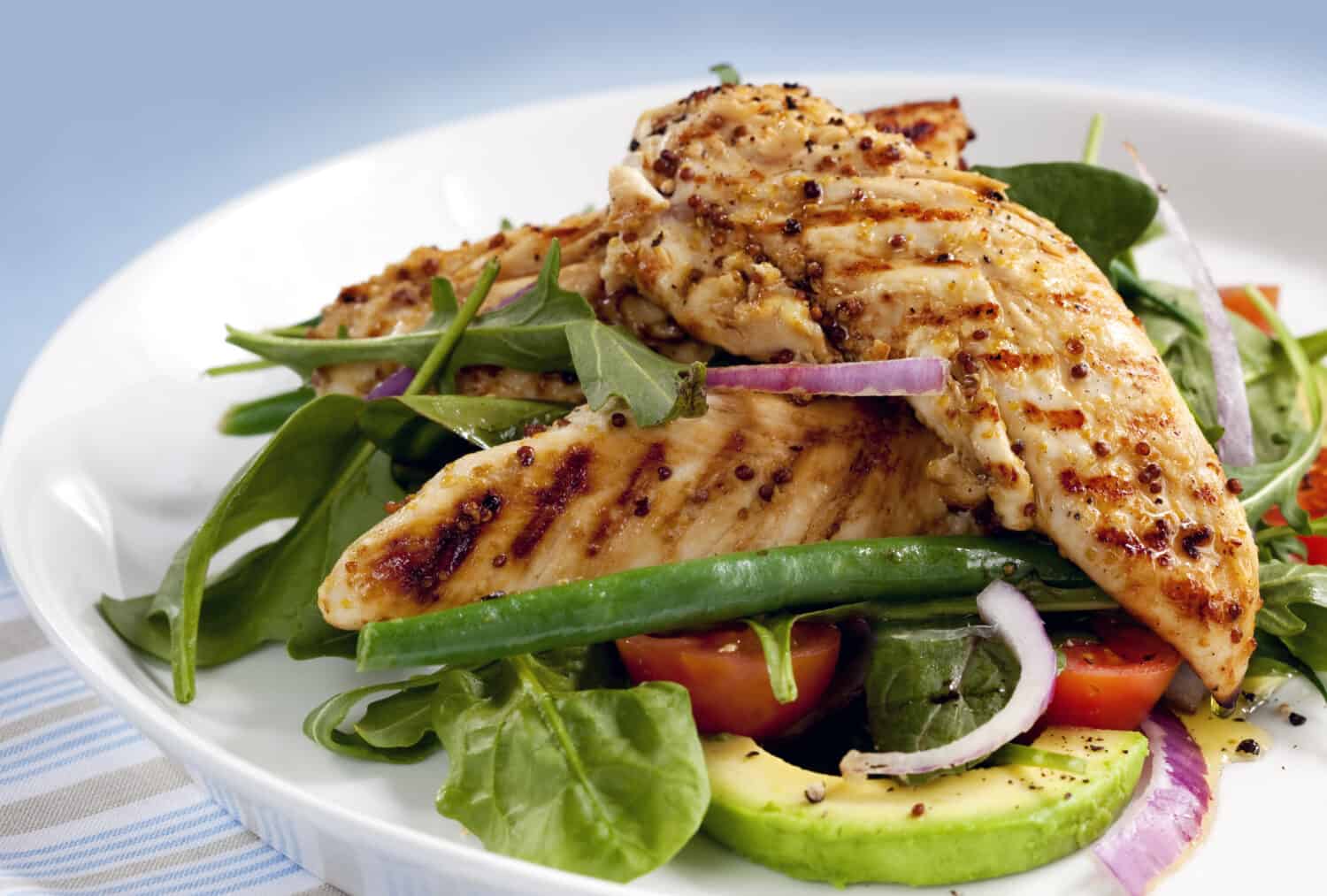When it comes to preparing a scrumptious chicken dish for your family, selecting the right cut of meat can make all the difference. But with so many options available, it's easy to feel overwhelmed. Today, we're tackling a common question: should I cook with chicken tenderloins or chicken breasts? And what's the difference between the two?
In short, the tenderloin is a tiny muscle found between the breast and the breast bone itself, whereas the chicken breast is a larger muscle found on the underside of the bird. Because these muscles are located in slightly different areas, they tend to differ in terms of flavor, texture, and size.
In this post, we'll not only discover the subtle differences between these two cuts of chicken meat but also give you the knowledge you need so you can decide which one is best for your next meal. Let's dive in!
Chicken Tenderloin vs. Chicken Breast: What are the Differences?
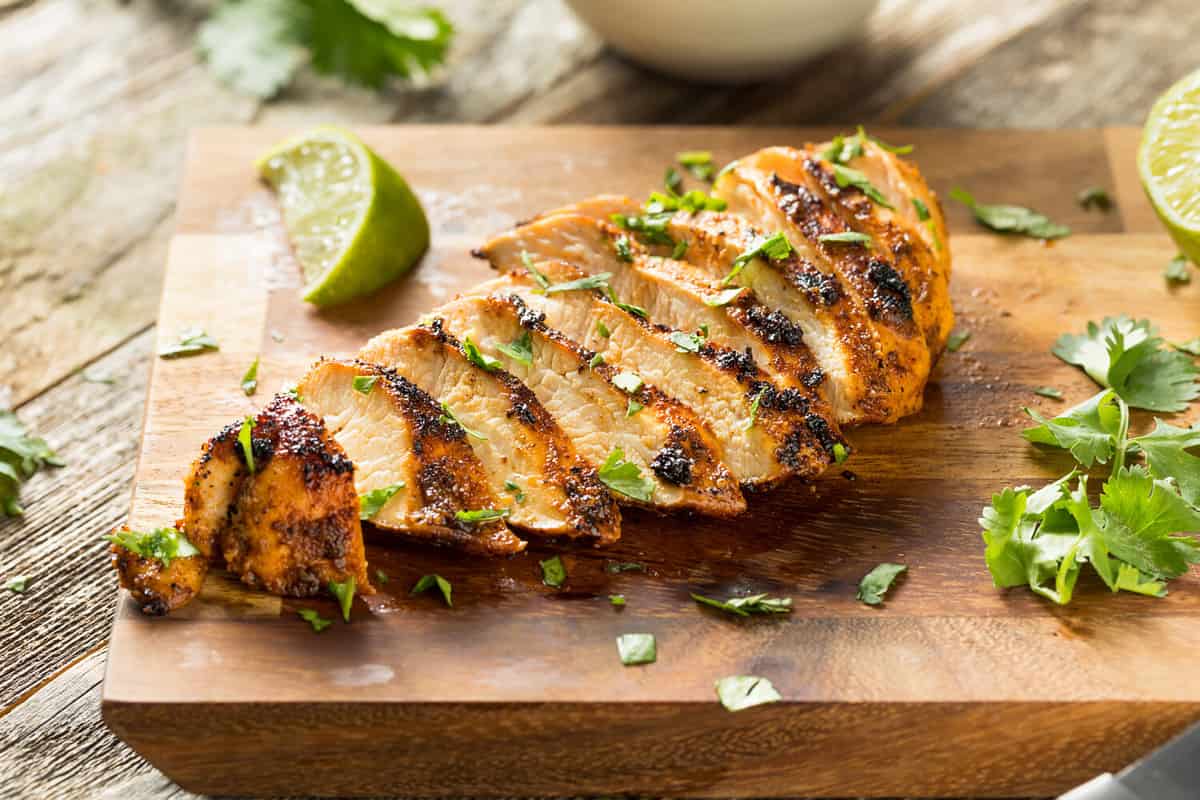
©Brent Hofacker/Shutterstock.com
As mentioned, the chicken tenderloin and chicken breast are muscles that are located in two different places on a chicken. The tenderloin tends to be more tender (hence its name) while chicken breast tends to be a bit more firm and mild. Let's take a closer look at what truly sets these two cuts apart.
Location
Chicken breasts are located on the front of the chicken's chest, known as the breastbone. They are the whole breast portion, including both the upper and lower parts. Chicken breasts are situated above the wings and extend to the chicken's back. They are the largest cut of meat obtained from the breast area.
Chicken tenderloins, on the other hand, are a specific muscle group found underneath the chicken breast. They are located on the inner side of the breastbone, closer to the chicken's rib cage. Tenderloins are slender strips of meat that run parallel to the breast, separate from the main breast portion.
Keep in mind that sometimes stores will slice up chicken breasts and use them to make chicken tenders. This is not the same as a chicken tenderloin. The tenderloin itself is a specific cut from a specific location on a chicken. They are not always used to make chicken tenders.
Size and Shape
As mentioned, chicken breasts are a larger cut of meat and are typically boneless. When purchasing them from your local grocery store, they may weigh anywhere from 3 to 8 ounces. They are also usually oval or teardrop-shaped and can be quite thick, especially in comparison to tenderloins. A chicken breast is typically larger and plump at one end, then taper to a point on the other end.
Chicken tenderloins are smaller and narrower in size compared to chicken breasts. They're typically about a quarter to a third of the size, too. Tenderloins are long and thin, resembling small strips or fillets, and can be paler in color than chicken breasts.
Texture and Tenderness
Chicken breast meat is lean and known for its firm texture. It has a slightly fibrous nature due to the presence of more muscle fibers. When cooked properly, chicken breasts can be tender and moist, but they will always be a bit coarser than the tenderloin.
Chicken tenderloins are naturally more tender than chicken breasts. When cooked, they have a softer texture with a delicate, melt-in-your-mouth quality. Their tenderness makes them a popular choice for various recipes, especially those requiring quick cooking methods.
Flavor
Chicken breast has a mild and versatile flavor. It provides a neutral base that can easily absorb flavors from marinades, spices, and sauces. These marinades can also affect the finished flavor of the chicken. Additionally, the flavor of chicken breasts can change depending on whether you're using a skin-on or skinless version, as well as a bone-in or boneless variety.
Due to the location of their cut being right next to the breast, chicken tenderloins taste extremely similar to chicken breasts. However, because they are slightly higher in sodium and fat and they have a more delicate texture, some argue that tenderloins are more flavorful. Like chicken breasts, tenderloins easily absorb marinades and seasonings which can affect the final cooked flavor of the meat.
Cooking Method
Due to their larger size and thicker texture, chicken breasts are often suitable for grilling, baking, roasting, and sautéing. They require longer cooking times to ensure they are cooked through without becoming dry. Additionally, chicken breasts are an excellent choice for marinades. The liquid from the marinade can help to improve their dry texture and mild flavor.
Chicken tenderloins are quick-cooking and well-suited for recipes that require shorter cooking times. They are ideal for stir-frying, breading and pan-frying, and grilling. They take less time to marinate due to their smaller size and are often used in dishes like salads, wraps, or stir-fry recipes. When cooking chicken tenderloins, keep an eye on the time. These don't take long to cook through and can become dry and tough if overdone.
Regardless of how either cut of chicken is cooked, it should reach an internal temperature of 165°F according to the USDA. This internal temp helps to ensure the chicken is fully cooked and void of bacteria that can cause food illnesses.
Chicken Tenderloin vs. Chicken Breast: Nutritional Value
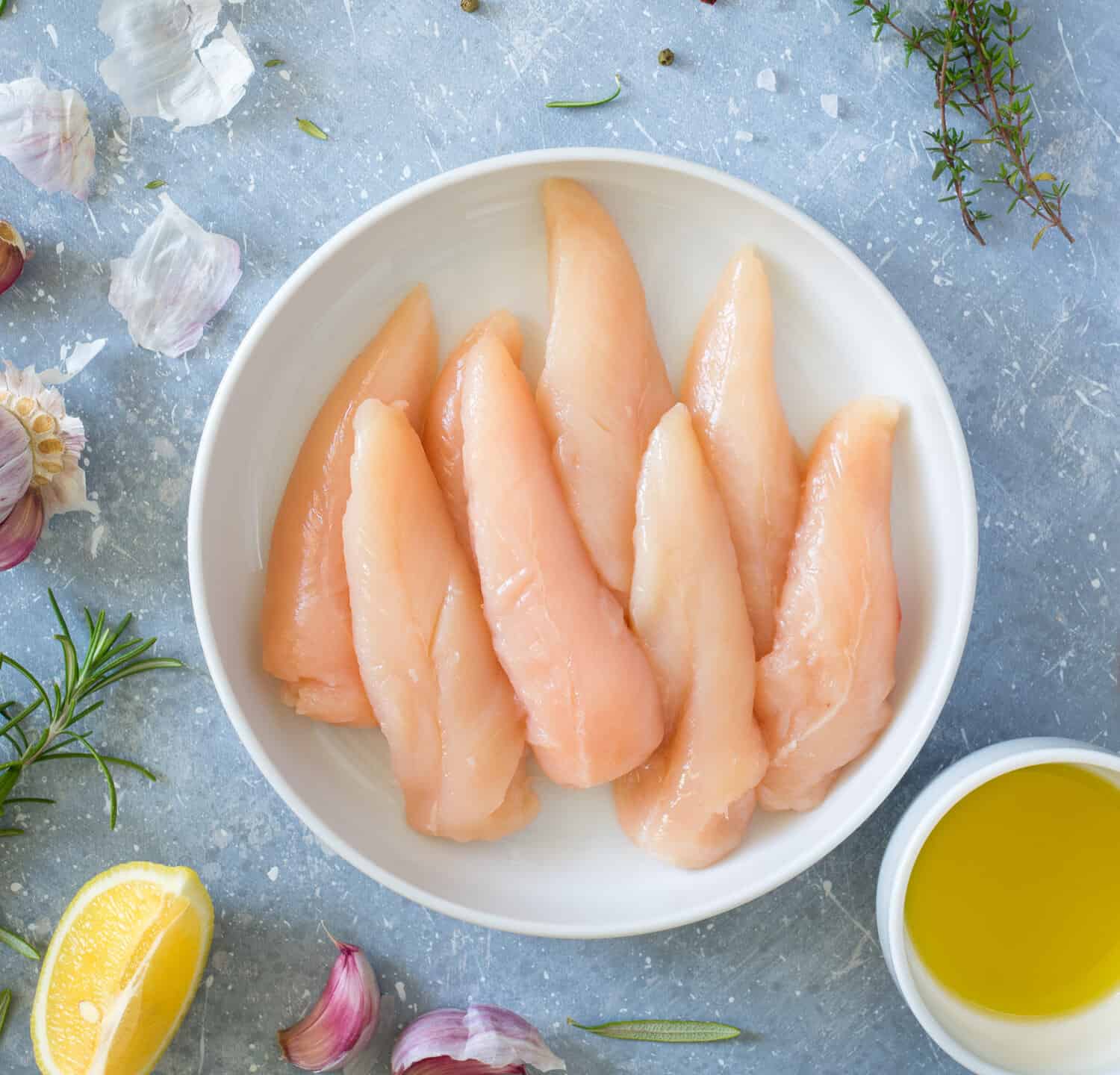
©Ina Ts/Shutterstock.com
Both chicken tenderloins and chicken breasts are lean sources of protein and are widely viewed as healthy choices. There are, however, some slight differences between the two cuts.
According to the USDA's food data center, 100 grams (3.5 ounces) of cooked chicken tenderloins contain:
- 89 calories
- 19.6 grams of protein
- 0.45 grams of fat
And, according to Healthline, 100 grams (3.5 ounces) of cooked chicken breasts contain:
- 165 calories
- 31 grams of protein
- 3.6 grams of fat
As you can see, chicken tenderloins tend to be a bit lighter all around. Chicken breasts are higher in protein, though, so if you're seeking a high-protein diet, you may want to opt for breasts over tenderloins.
It's important to note that the exact nutritional values may vary slightly depending on the cooking method and any added ingredients or marinades. Additionally, the nutritional content may differ based on the specific type of chicken (like organic, free-range, etc.) and any variations in fat content. Therefore, it's always a good idea to refer to the specific nutritional information provided on the packaging.
Can you Substitute Chicken Tenderloin for Chicken Breast?
Yes, you can substitute chicken tenderloin for chicken breast and vice versa in your next recipe! Just keep in mind that while these are easy to substitute, they are not the exact same.
For instance, chicken tenderloin tends to be smaller than chicken breasts, so you may not have the exact amount that you need for your next recipe. Chicken tenderloins also tend to cook more quickly and be more tender. This may mean you'll need to adjust your cooking time and seasoning depending on what your recipe calls for.
Overall, substituting chicken tenderloins for chicken breasts works well in many recipes, especially when you're looking for a quicker cooking time and a more tender texture. Before making the swap, however, be sure to consider the specific recipe you're working with and the cooking method needed.
Chicken Tenderloin Recipes
Print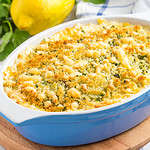
Potato-crusted Chicken Casserole
- Yield: 6 servings 1x
Ingredients
1 large potato, thinly sliced*
1 Tablespoon olive oil
½ teaspoon salt
¼ teaspoon pepper
FILLING:
1½ pounds chicken tenderloins, cut into ½-inch cubes
2 teaspoons olive oil
1 medium onion, chopped
1 Tablespoon butter
2 Tablespoons all-purpose flour
1½ cups fat-free milk
¼ cup shredded part-skim mozzarella cheese
¼ cup grated Parmesan cheese
2 Tablespoons shredded reduced-fat cheddar cheese
2 cups frozen peas and carrots
½ teaspoon salt
½ teaspoon dried thyme
¼ teaspoon dried basil
Dash rubbed sage
CRUMB TOPPING:
1 cup soft bread crumbs
1 Tablespoon butter, melted
½ teaspoon garlic powder
*Potato slices tested at 1/16 of an inch using a mandolin
Instructions
1. In a large bowl, toss potato slices with oil, salt, and pepper.
2. Arrange slices onto the bottom and sides of an 11-in. x 7-in. baking dish coated with cooking spray. Bake at 400° for 20-25 minutes or until potato is tender. Reduce heat to 350°.
3. Meanwhile, for filling, in a large skillet over medium heat, cook chicken in oil until no longer pink. Remove from skillet.
4. In the same skillet, sauté onion in butter.
5. Stir in flour until blended; gradually add milk. Bring to a boil; cook and stir for 2 minutes or until thickened.
6. Reduce heat; stir in cheeses until melted.
7. Stir in vegetables, seasonings and chicken. Spoon into potato crust.
8. Combine topping ingredients; sprinkle over chicken mixture. Bake, uncovered, for 40-45 minutes or until bubbly and topping is golden brown.
Nutrition
- Serving Size: 1 serving
- Calories: 340
- Sodium: 674mg
- Fat: 11g
- Saturated Fat: 4g
- Carbohydrates: 28g
- Fiber: 3g
- Protein: 35g
- Cholesterol: 85mg
Chicken Breast Recipes
Final Thoughts
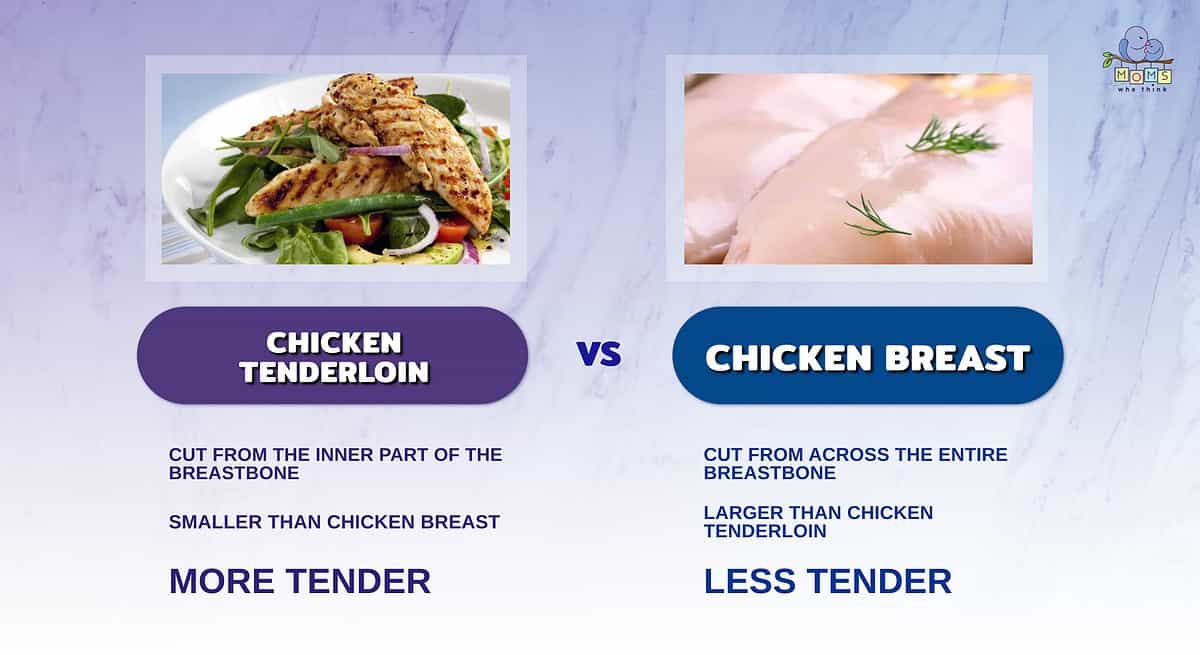
- Chicken tenderloin is cut from the inner part of the breastbone, while chicken breast is cut from across the entire breastbone. Although these cuts are close in location, they are distinct.
- As you might expect, chicken breasts are larger than chicken tenderloins.
- Chicken tenderloin is always going to be more tender than chicken breast. Don't mistake a chicken breast for dry and coarse, though; when cooked well, it can be plenty moist and tender.
When it comes to comparing chicken tenderloins and chicken breasts, both cuts have their own unique characteristics. Chicken tenderloins, a smaller and more delicate muscle, are known for tenderness and a quick-cooking quality. Chicken breasts, on the other hand, are larger and firmer, providing a substantial texture and versatility. Whichever option you choose is sure to provide a delicious chicken dish your family will love. Happy cooking!
The image featured at the top of this post is ©60694/Shutterstock.com.
